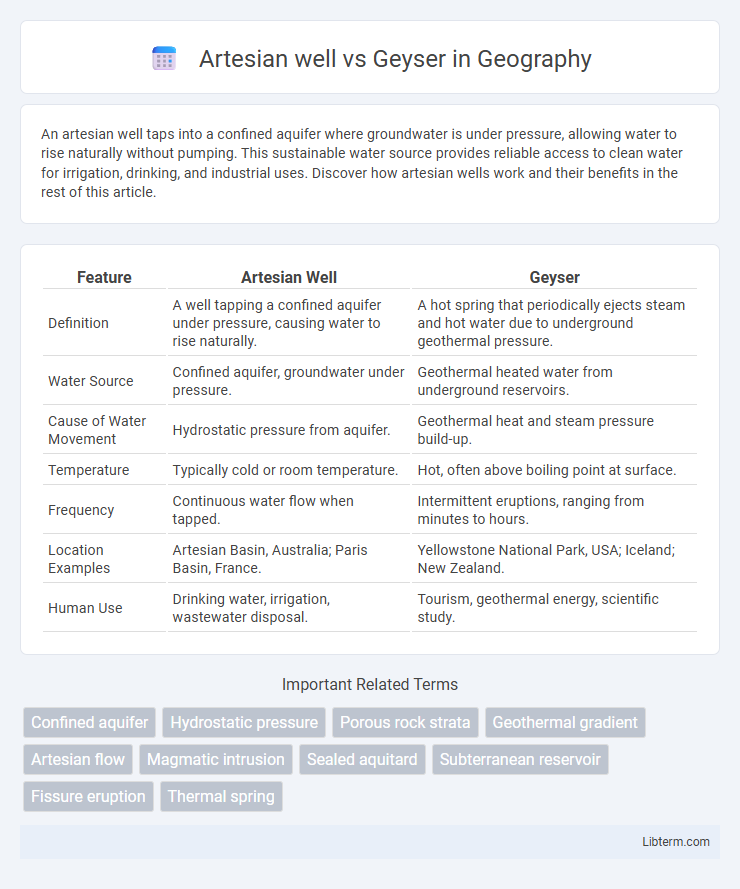An artesian well taps into a confined aquifer where groundwater is under pressure, allowing water to rise naturally without pumping. This sustainable water source provides reliable access to clean water for irrigation, drinking, and industrial uses. Discover how artesian wells work and their benefits in the rest of this article.
Table of Comparison
| Feature | Artesian Well | Geyser |
|---|---|---|
| Definition | A well tapping a confined aquifer under pressure, causing water to rise naturally. | A hot spring that periodically ejects steam and hot water due to underground geothermal pressure. |
| Water Source | Confined aquifer, groundwater under pressure. | Geothermal heated water from underground reservoirs. |
| Cause of Water Movement | Hydrostatic pressure from aquifer. | Geothermal heat and steam pressure build-up. |
| Temperature | Typically cold or room temperature. | Hot, often above boiling point at surface. |
| Frequency | Continuous water flow when tapped. | Intermittent eruptions, ranging from minutes to hours. |
| Location Examples | Artesian Basin, Australia; Paris Basin, France. | Yellowstone National Park, USA; Iceland; New Zealand. |
| Human Use | Drinking water, irrigation, wastewater disposal. | Tourism, geothermal energy, scientific study. |
Introduction to Artesian Wells and Geysers
Artesian wells tap into confined aquifers where groundwater is under positive pressure, causing water to rise naturally without pumping. Geysers are rare hydrothermal features where underground heat and pressure force periodic eruptions of steam and hot water. Both phenomena illustrate the movement of groundwater under pressure but differ in heat source, with artesian wells relying on aquifer pressure and geysers on geothermal activity.
Definition and Basic Concepts
An artesian well is a type of well where water rises to the surface naturally due to pressure in a confined aquifer, without the need for pumping. A geyser is a hot spring characterized by intermittent discharge of water and steam caused by underground geothermal heat and pressure. Both involve the movement of groundwater, but artesian wells are driven by hydrostatic pressure in permeable rock layers, while geysers rely on volcanic activity heating water trapped underground.
Formation Processes: Artesian Wells vs Geysers
Artesian wells form when groundwater trapped between impermeable layers of rock is under pressure, allowing water to flow to the surface naturally through a well. Geysers develop in geothermal areas where underground water is heated by magma, causing pressure buildup and periodic eruptions of steam and hot water. The key difference lies in artesian wells relying on hydrostatic pressure without heat, while geysers depend on geothermal heat and steam-driven eruptions.
Geological Settings and Locations
Artesian wells form in confined aquifers where groundwater is trapped between impermeable rock layers, creating pressure that forces water to rise naturally, commonly found in sedimentary basins like the Great Artesian Basin in Australia. Geysers occur in volcanic regions with intense geothermal activity, such as Yellowstone National Park, where underground water is heated by magma, generating steam pressure that triggers periodic eruptions. The distinct geological settings--confined aquifers for artesian wells and hydrothermal systems for geysers--dictate their occurrence and behavior.
Water Source and Pressure Dynamics
Artesian wells tap into confined aquifers where water is trapped under pressure between impermeable rock layers, causing it to rise naturally without pumping when the well penetrates the pressurized zone. Geysers occur when groundwater is superheated by geothermal heat, creating steam that forces water and steam to erupt intermittently through surface vents due to pressure build-up and release cycles. The key difference lies in artesian wells utilizing aquifer pressure for continuous flow, while geysers depend on temperature-induced pressure changes for sporadic eruptions.
Temperature Differences: Cold vs Hot Water
Artesian wells typically yield cold water sourced from underground aquifers under natural pressure, maintaining temperatures close to the surrounding earth's average. Geysers discharge hot water and steam due to geothermal heating, often reaching temperatures above 100degC (212degF) as water is superheated by magma. The significant temperature difference highlights artesian wells as sources of cool, stable water, while geysers demonstrate dynamic, high-temperature geothermal activity.
Environmental Impact and Benefits
Artesian wells provide a sustainable water source by tapping confined aquifers without the need for energy-intensive pumping, minimizing surface disruption and reducing groundwater depletion risks. Geysers, as natural hydrothermal features, release steam and heated water that support unique ecosystems but can be sensitive to human interference and geothermal energy exploitation. Both contribute to ecological balance: artesian wells sustain agricultural and domestic water needs while preserving aquifer integrity, and geysers maintain habitat biodiversity and geothermal heat flow stability.
Human Uses and Applications
Artesian wells provide reliable, contaminant-free groundwater for agricultural irrigation, drinking water, and industrial processes, supporting sustainable water management in arid regions. Geysers, though less directly utilized for water extraction, offer geothermal energy potential and attract tourism, contributing to local economies. Both natural phenomena demonstrate critical roles in resource utilization, with artesian wells prioritized for consistent water supply and geysers leveraged primarily for energy and recreational value.
Famous Examples Around the World
The Great Artesian Basin in Australia is one of the world's largest artesian wells, providing a reliable water source across vast arid regions. In contrast, Yellowstone National Park in the USA hosts famous geysers like Old Faithful, which erupt spectacularly due to geothermal activity. The Carlsbad Hot Springs in New Mexico also exemplify geothermal geysers with their regular, high-pressure water ejections.
Key Differences Summarized
An artesian well taps into confined aquifers where groundwater is under natural pressure, causing water to rise above the aquifer without pumping. A geyser is a rare geothermal feature where superheated groundwater intermittently erupts due to pressure build-up, releasing steam and hot water forcefully. Key differences include artesian wells being controlled water sources with steady flow, whereas geysers are natural, unpredictable hydrothermal eruptions.
Artesian well Infographic

 libterm.com
libterm.com